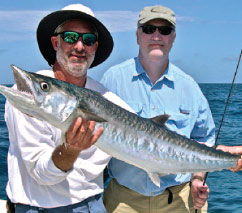The Tampa Bay Times
Capt. Brent Gaskill
When the wind blows from the south trout tend to bite better. Southerly winds typically occur prior to approaching frontal systems, which also encourages the fish to feed aggressively. From now through spring I like to fish expansive grass flats that have good drifting lanes aligning with the southerly breezes. Casting artificial lures with the wind, ahead of the drift connects with fish that have not already been spooked by the boat passing overhead. One of my favorite lures to throw in this scenario is a float-and-jig combo made popular years ago by Bill and Steve Love of old Love’s Lures fame. The combo is a simple twist on the traditional popping cork set up where a very small cigar shaped float is attached to the leader about 18” ahead of a plastic tail jig. The float is worked across the surface with splashing pops imitating the sound of feeding fish while the jig follows along below. The sound of the float on the surface attracts the attention of nearby trout making them look up to see the jigs erratic action drawing the strike. One of the advantages of this combination is that different size lead heads or different color tails can easily be swapped out. If there’s a down side to the float-and-jig combo is that many other species are also attracted to the commotion it makes on the surface including redfish, snook, Spanish mackerel, bluefish, cravalle jacks, lady fish, and more. Focusing casts to the edges of sandy holes scattered throughout the grass will connect with spotted sea trout hiding in ambush mode.
- Jay Mastry - March 26, 2024
- Captains Corner, Gorta - March 23, 2024
- Dave Zalewski - March 12, 2024










